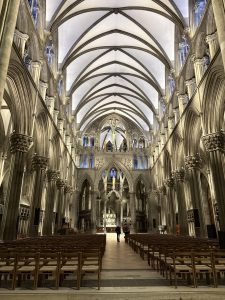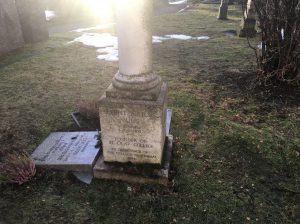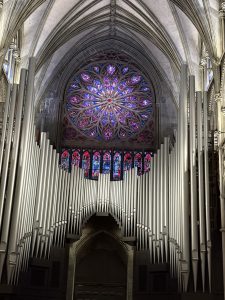By: Alana Schmitzer, Leo Griffey-Briam, Emma Clift, Amasa Evesen
On January 17th, we did a group tour of the Nidaros Cathedral. We enjoyed seeing the Gothic architecture and one of the most notable buildings in Trondheim. It was also unique because the usually busy Cathedral was almost empty. This allowed us to move freely and fully experience the Cathedral’s amazing acoustics.
Learning about the history of Nidaros Cathedral was a little sad. It was originally built with Romanesque architecture in 1070, but has been through five fires and was rebuilt with Gothic architecture. Our tour guide told us about the church losing power in Norway and the cathedral falling into disrepair. However, in 1869 the state gave money for the cathedral to be restored to its former glory. It was disappointing to learn that what we were looking at was all new and created by people assuming what it looked like since no one knew what it originally looked like. The cathedral was built in the shape of a Gothic cross and houses a huge Steinmeyer organ at the bottom of the cross. Something interesting we learned was that they fully finished repairs in 2001, only a few years older than most of us on the trip.
The founder of St. Olaf College, Bernt Julius Muus, is buried in the graveyard outside the cathedral. He was originally from Norway and founded the school to preserve Norwegian identity in the US. Muus is not very well-known on campus because later in his life he got a lot of negative publicity from his divorce trial. In 1900, after suffering multiple strokes, his daughter brought him to Norway so he could die in his home country, and they buried him at Nidaros because of its association with St. Olaf. It was interesting to learn about our college’s founder and why we didn’t know much about him.
Within the Cathedral, there were 6 colored statues while the rest of the cathedral was relatively dark. The guide explained that the cathedral used to be significantly more colorful than it is now. Especially in a darker building, it was important to have the inside be very colorful to reflect as much light as possible. For example, they used to make a lot of the inside gold because it reflected light, making the inside of the Cathedral brighter.
When walking through the cathedral, we noticed that the stained glass windows were quite a bit darker than what we see in churches back home. Before designing the windows, the man who created them visited other places to gain inspiration for the design he would create on the windows. The windows he saw were darker, so he assumed that was normal for the Gothic cathedral look and architecture. However, after creating them, he learned that the windows he saw for inspiration were just very dirty, hence why they were dark. So, the stained glass windows in the Nidaros Cathedral appear “dirty” because of their darkness, but in reality, they were just created darker due to a mistake.
Overall, it was very interesting to see the Nidaros Cathedral. We went back to the Cathedral later to observe an organ practice session, but unfortunately, they were not practicing that day. Regardless, we all enjoyed seeing the cathedral and feel lucky we saw it on such a beautiful day!


